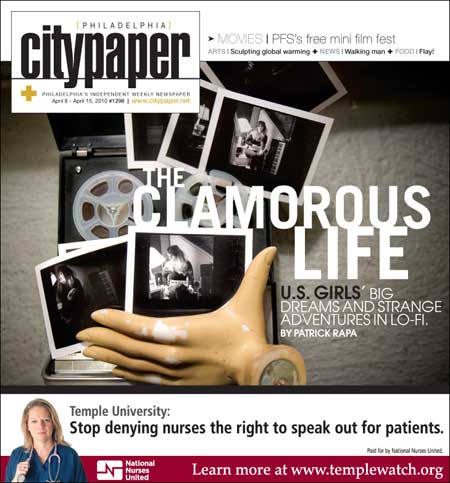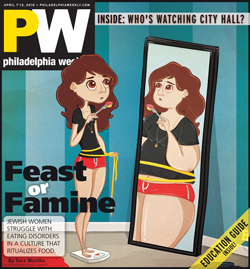 BY DAVE ALLEN Like time, news waits for no man. Keeping up with the funny papers has always been an all-day job, even in the pre-Internets era. These days, however, it’s a two-man job. That’s right, these days you need someone to do your reading for you, or risk falling hopelessly behind and, as a result, increasing your chances of dying lonely and somewhat bitter. That’s why every week PAPERBOY does your alt-weekly reading for you. We pore over those time-consuming cover stories and give you the takeaway, suss out the cover art, warn you off the ink-wasters and steer you towards the gooey center. Why? Because we love you!
BY DAVE ALLEN Like time, news waits for no man. Keeping up with the funny papers has always been an all-day job, even in the pre-Internets era. These days, however, it’s a two-man job. That’s right, these days you need someone to do your reading for you, or risk falling hopelessly behind and, as a result, increasing your chances of dying lonely and somewhat bitter. That’s why every week PAPERBOY does your alt-weekly reading for you. We pore over those time-consuming cover stories and give you the takeaway, suss out the cover art, warn you off the ink-wasters and steer you towards the gooey center. Why? Because we love you!
ON THE COVER
CP: Music is hard to write about. Strictly as sound, it doesn’t stick around for long; try to drag it out of memory and pin it down with too many vague adjectives, and you kill it. This is what makes Pat Rapa’s cover on Meghan Remy and her project U.S. Girls so notable. First, he wraps his head around a sound and a genre. This is key.
The “band” is just her and a whole mess of equipment: microphones, a busted drum machine, a failing four-track, an old reel-to-reel player and other less-than-cutting-edge electronic  devices. Her songs are noisy, hazy things. Ghostly and all but incoherent, her voice rises and falls beneath thick layers of distortion and snippets of white noise. There are hints and glimmers of recognizable rock conventions — a little bit of pop energy, an occasional catchy chorus — but it’s pretty safe to say U.S. Girls is not for everyone.
devices. Her songs are noisy, hazy things. Ghostly and all but incoherent, her voice rises and falls beneath thick layers of distortion and snippets of white noise. There are hints and glimmers of recognizable rock conventions — a little bit of pop energy, an occasional catchy chorus — but it’s pretty safe to say U.S. Girls is not for everyone.
The catch-all label that fits here is “lo-fi,” although there are few stylistic similarities among the many bands and artists that get sorted that way. Suicide, a synth-punk duo that got its start with a few messy albums in the 1970s, is one of the earliest and most influential lo-fi groups. These days, garage bands with fuzzed-out vocals like No Age, Times New Viking and Pissed Jeans get the tag.
“I think U.S. Girls can be put into a subgenre within the female ‘bliss’ movement,” says KPC, a DJ at Princeton’s free-form radio station WPRB. He points to artists like LA Vampires, Psychic Reality and Pocahaunted. “The thing that separates U.S. Girls from this crowd, however, is her harsher sounds and use of extreme delay and echo.” She goes for gritty and low-tech, not pretty.
I’ve never heard U.S. Girls, and yet, I’m there. How she got here, how she became the artist she is, and what sets her apart from the rest – knowledge of her roots and a love of Springsteen go a long way – all follow from that point, and I’m hooked. There seem to be a lot of “girl” bands out there, and many of them – Dum Dum Girls, Vivian Girls, just plain Girls – have passed through Philadelphia in my short time here. After Rapa’s story, I don’t think I’ll likely mistake U.S. Girls for any of the others anytime soon.
PW: It takes a couple grafs to get there, but Tara Murtha’s cover story made an interesting connection between something I didn’t know before – there’s a well-known treatment center for eating disorders in Philly – and something I didn’t think I’d be interested in knowing: the occurrence of eating disorders in the Jewish faith, which, especially in the just-ended time of Passover, focuses a great deal on food and on what is and is not right to eat. Murtha centers on Hilary, who was treated at Philly’s Renfrew Center.
 For all the time she spent calculating intake and output, figuring out whether to prioritize health or faith wasn’t an easy equation.
For all the time she spent calculating intake and output, figuring out whether to prioritize health or faith wasn’t an easy equation.
“I fasted on every Yom Kippur and every fast day since I was 13 years old and here I [was] being told, ‘you’re not allowed to do this anymore’ … I felt disconnected from my Jewish community. It was the same with changing my diet for Passover,” she says.
Hilary says it was hard to celebrate holidays and share family meals while the eating disorder was “active” and she was trying to hide it. Now that she’s in recovery, it’s hard not to participate—despite still being active in the Jewish community, she has chosen not to keep kosher or observe Jewish holidays and traditions that involve feasting or fasting.
She says, “It’s just one example of how an E.D. just sucks the joy out of your life.”
I’ll be honest, I expected a kind of “oh, by the way, this still exists” article, the kind that pop up about HIV or homelessness, things that are pervasive enough as to escape notice. But the connection Murtha establishes between the ritualism of Judaic rites and the systematized, almost ritual, formulations of a person suffering an eating disorder was too fascinating to deny. It’s a topic that could have been fodder for a Lifetime made-for-TV movie, but this take redeems and reveals it as something more.
INSIDE THE BOOK
CP: Cynical Cynthias run this town. “A serious analysis of one person’s head,” now on Day 3. Kaffe Fassett: I wish I could quilt you. Another Iron Chef? I’ll care if he can back up Kevin Kolb.
PW: The City Council Uncertainty Principle: what are they up to, anyway? WTPh: Phillies fan bored by their success. Too much and you’ll go blind, art gallery edition. Friend of the Devil: No more Uncle Ho’s Hot Sticks.
WINNER: I’ll take Pat Rapa and CP this week. You don’t have to know who Times New Viking are (I did), or where Siltbreeze Records is (I didn’t) to appreciate his piece. U.S. Girls’ music may be far from polished, but the story behind it, and Remy’s way of talking about, are gems.
